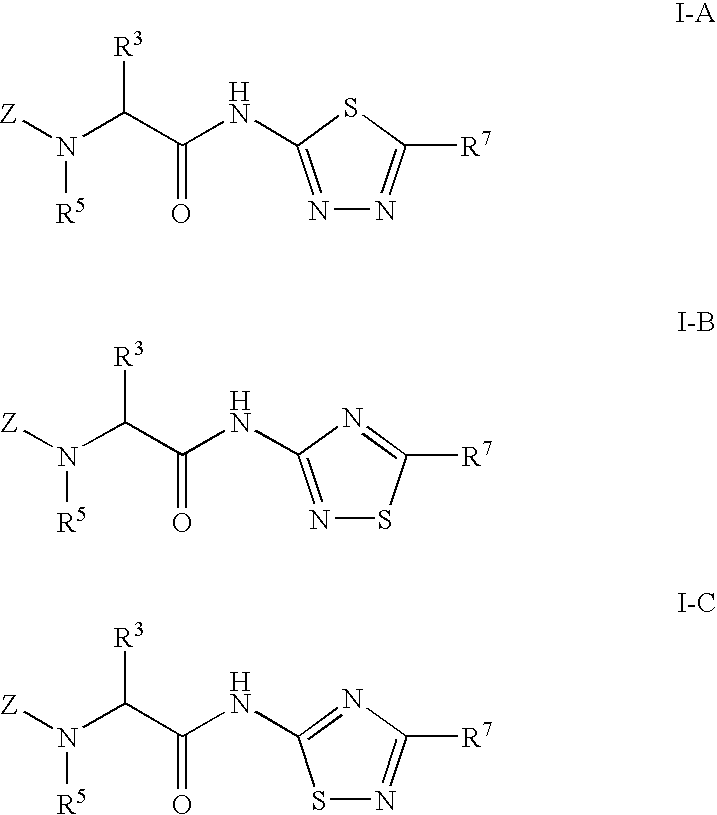Compounds for the treatment of neurodegenerative disorders
a neurodegenerative disorder and compound technology, applied in the field of compound for the treatment of neurodegenerative disorders, can solve the problems of nerve cell destruction, increased plaque formation, increased risk of ad, etc., and achieves the effects of increasing in vivo half-life, reducing the risk of ad, and facilitating preparation and detection
- Summary
- Abstract
- Description
- Claims
- Application Information
AI Technical Summary
Benefits of technology
Problems solved by technology
Method used
Image
Examples
example 1
2-[2-(3,5-Difluoro-phenyl)-acetylamino]-pentanoic acid (5-tert-butyl-[1,3,4]thiadiazol-2-yl)-amide
[0273]A mixture of 3,5-di-fluoro-phenyl acetic acid (51.6 mg, 0.3 mmol), 2-amino-pentanoic acid (5-tert-butyl-[1,3,4]thiadiazol-2-yl)-amide (88 mg, 0.3 mmol), HBOT (43 mg, 0.315 mmol), EDC HCl (69 mg, 0.36 mmol.) and triethylamine (0.17 ml) in methylene chloride was stirred at room temperature until product formation or disappearance of starting material. The mixture was quenched with water and extracted with methylene chloride. The organic layer was separated, washed with dilute HCl, brine, dried over sodium sulfate and the solvent was removed at reduced pressure to provide the title compound as a cude oil. The oil was purified by Shimadzu HPLC to provide the title compound as a white solid (56 mg), LC-MS M+1=411.2, 1H NMR(CDCL3) 8.7 (d, 1H,NH), 6.73(m,2H), 6.6(m, 1H), 4.7(m, 1H), 3.5(Abq, 2H), 1.6-1.9(m,2H), 1.3-1.6(m,2H), 1.5(s,9H), 0.92(t,3H) ppm.
example 2
2-[2-(3,5-Difluoro-phenyl)-acetylamino]-pentanoic acid [5-(2-phenyl-propylsulfanyl)-[1,3,4]thiadiazol-2-yl]-amide
[0274]A mixture of 2-[2-(3,5-difluoro-phenyl)-acetylamino]-pentanoic acid (25.4 mg, 0.2 mmol), 5-(2-phenyl-propylsulfanyl)-[1,3,4]thiadiazol-2-ylamine (50 mg, 0.2 mmol), HBOT (29 mg, 0.21 mmol), EDC HCl (46 mg, 0.24 mmol.) and triethylamine (0.12 ml) in methylene chloride was stirred at room temperature until product formation or disappearance of starting material. The mixture was quenched with water and extracted with methylene chloride. The organic layer was separated, washed with dilute HCl, brine, dried over sodium sulfate and the solvent was removed at reduced pressure to provide the title compound as a cude oil. The oil was purified by Shimadzu HPLC to provide the title compound as a light yellow solid (26 mg), LC-MS M+1=505.0
example 3
2-(2-Hydroxy-3-methyl-butyrylamino)-pentanoic acid (5-tert-butyl-[1,3,4]thiadiazol-2-yl)-amide
[0275]A mixture of 2-(S)-hydroxyl-3-methyl-butyric acid (35.4 mg, 0.3 mmol), 2-amino-pentanoic acid (5-tert-butyl-[1,3,4]thiadiazol-2-yl)-amide (88 mg, 0.3 mmol), HBOT (43 mg, 0.21 mmol), EDC HCl (69 mg, 0.36 mmol.) and triethylamine (0.17 ml) in 2 ml of methylene chloride was stirred at room temperature until product formation or disappearance of starting material. The mixture was quenched with water and extracted with methylene chloride. The organic layer was separated, washed with dilute HCl, brine, dried over sodium sulfate and the solvent was removed at reduced pressure to provide the title compound as a cude oil. The oil was purified by Shimadzu HPLC to provide the title compound as a light yellow solid (44 mg), LC-MS M+1=357.1
[0276]The following compounds were prepared by the methods analogous to those describered in Examples 1, 2, or 3.[0277]2-[2-(3,5-Difluoro-phenyl)-acetylamino]-p...
PUM
| Property | Measurement | Unit |
|---|---|---|
| temperature | aaaaa | aaaaa |
| temperature | aaaaa | aaaaa |
| temperature | aaaaa | aaaaa |
Abstract
Description
Claims
Application Information
 Login to View More
Login to View More - R&D
- Intellectual Property
- Life Sciences
- Materials
- Tech Scout
- Unparalleled Data Quality
- Higher Quality Content
- 60% Fewer Hallucinations
Browse by: Latest US Patents, China's latest patents, Technical Efficacy Thesaurus, Application Domain, Technology Topic, Popular Technical Reports.
© 2025 PatSnap. All rights reserved.Legal|Privacy policy|Modern Slavery Act Transparency Statement|Sitemap|About US| Contact US: help@patsnap.com



